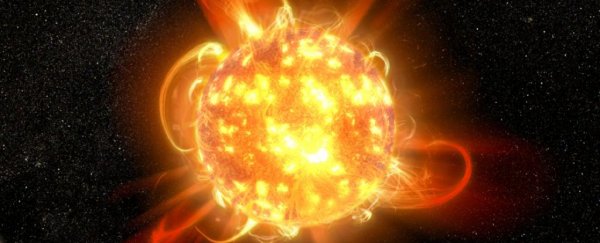It was the year 2000 and scientists had never seen anything like it: astronomers reported evidence of "superflares" on distant stars – solar outbursts many thousands of times more energetic than typical solar flares.
As researchers observed over subsequent studies, these intense eruptions were more common on young, rapidly rotating stars, and on stars exhibiting high levels of magnetic activity. Perhaps our much older, quieter Sun would never do such a violent thing, we speculated.
"It has been thought that slowly rotating Sun-like stars basically do not have high magnetic activity events like superflares," a team of astronomers led by Yuta Notsu from the University of Colorado Boulder explains in a new paper – which, unfortunately, suggests our assumption looks to be mistaken.
In a new analysis of superflare events observed by the Kepler space telescope, the researchers report that superflares can indeed be produced by Sun-like stars, albeit much less frequently than by younger, more magnetically active stars.
"Our study shows that superflares are rare events," says Notsu.
"But there is some possibility that we could experience such an event in the next 100 years or so."
Before now, scientists had witnessed Sun-like stars – meaning G-type main-sequence stars – produce superflares, although we still can't fully explain how these high-energy events are unleashed, partially due to a lack of analysis.
To understand more, Notsu's team ran new spectroscopic observations with Kepler data, also utilising data from the European Space Agency's Gaia spacecraft and the Apache Point Observatory in New Mexico.
In all, they found evidence of 43 Sun-like stars that had produced superflares in the past – and while their statistical analysis offers clearer insights into the characteristics of these energetic outbursts, ultimately the researchers say we need even more data to understand how likely a superflare from the Sun might be.
"We need more studies to clarify the properties of superflare stars on Sun-like stars and to answer the important question, 'Can our Sun have superflares?'" the team writes.
"The number of old, slowly rotating Sun-like superflare stars [observed] are now very small, and the current statistical discussions are not enough."
Be that as it may, Notsu says the more we learn about superflares, the more we realise that while they might be more common on younger stars, Sun-like stars are definitely not precluded from this powerful, and potentially very dangerous form of stellar phenomena.
"Young stars have superflares once every week or so," Notsu says.
"For the Sun, it's once every few thousand years on average."
That loose certainty is all we have for now, but it's imperative we try to refine our knowledge in the future – not just about the likelihood of a superflare emanating from the Sun, but also what might happen if it comes to pass.
Existing research suggests a powerful-enough solar flare could wipe out technology as we know it, causing potentially trillions of dollars of damage worldwide, and triggering all kinds of weird, unforeseeable catastrophes.
If that flare turns out to be an immense superflare like the kind astronomers have witnessed occurring hundred of light-years away? Well, the truth is we don't really know how bad it could be.
"More accurate evaluations of the effects of superflares is a next urgent task," Notsu explained to Astronomy.
"But we can now expect things such as large-scale blackouts, satellite communication failure, and strong radiation in space… This topic should [start to be considered] seriously from now on."
The findings are reported in The Astrophysical Journal.
